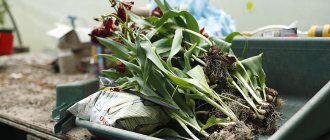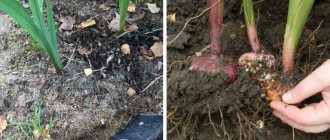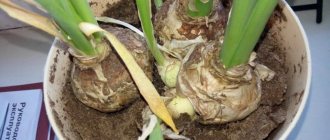The dahlia is a lovely plant often grown in the garden and is ideal for cut flowers. It delights us with a huge variety of beautiful flowers of various shapes, sizes and a wide range of colors. Planted in a sunny location, it blooms profusely from mid-summer until the first autumn frosts. When to dig and how to store dahlia tubers in winter at home, in the basement (cellar) after digging - this will be discussed in this article.
Dahlias belong to the Asteraceae family and come from the warm climate of Central America - from Mexico and Guatemala. These perennial plants freeze and die in our climatic conditions, so they are grown as annuals. Due to their sensitivity to frost, they need to be dug up for the winter.
When and how to dig up dahlias in the fall: detailed instructions
- Dahlias need to be dug up in the fall. It is better to do this as soon as the first frosts appear. If you notice that the leaves of the flower have darkened, then it’s time to dig for planting material that will come in handy in the spring.
- If you hesitate to dig up the tubers, there is a chance that bud growth will be activated. warming occurs . If after small frosts it gets even colder, the plant may not survive this and will die.
- The timing of when to dig up dahlias in the fall is not exact. It all depends on the climatic characteristics of your region. Dahlias in the Moscow region should be dug up at the end of September or beginning of October. Dahlias in Siberia and the Urals need to be dug up in the middle or end of September.
Digging up tubers
- Look at the weather conditions. As soon as the temperature drops below 0°C, immediately begin digging.
Let's move on to digging:
- If you are going to dig up dahlias, step back a little from the flower. The main disadvantage of the plant is its fragile root system. If you damage it during the digging process, then next year the flower will not bloom and will disappear. Try to retreat 20-25 cm from the bush.
- Pre-cut the stem, retreating 15-17 cm from the neck of the roots. Do not pull the buried flower so as not to damage it. If the tubers are heavily covered with soil, do not shake it off. There is a safer way to get rid of it. It is necessary to place the roots of the flower in the sun so that they dry a little. After this, just run your hand over the ground a little and it will crumble.
You can rinse and dry or leave to dry and knock off the soil
- Don't forget to inspect the tubers for diseases and damage. Only high-quality and healthy planting material is suitable for winter storage. If stains are noticed on the surface (brown, black or rusty), it is better to cut . To do this, use a clean knife or pruning shears. To be safe, treat your instruments with a disinfectant and disinfectant.
- To select high-quality planting material, use this secret. Place all the tubers in a bowl of water. If some specimens catch fire , they should be thrown away.
Recommendations
To obtain well-ripened dahlia tubers ready for storage, a number of conditions must be met:
- plant flowers in sunny, dry areas;
- do not overfeed plants with fertilizers in the second half of summer, especially with manure;
- Plant dahlias in slightly acidic or neutral soils.
When digging, it is important to be careful not to cut or break off pieces of the root. Each wound on a tuber increases the risk of rot during storage.
It is recommended to divide large dahlia rhizomes before storing them, and not in the spring. A tuber rhizome that is too large is more difficult to preserve than a cutting.
Today we looked at when to dig up dahlias in the fall and how to store them. We hope the information will be useful to you. Bright flower beds!
Olga Springer Gardener with 30 years of experience. The land plot is located in the area of Novokuznetsk (Kemerovo region, south of Western Siberia). Area of interest: growing various garden crops. Working principle: ...
Do I need to dig up dahlias for the winter?
- Many flower growers who are just starting to grow flowers are wondering whether it is necessary to dig up dahlias for the winter or not? Unfortunately, this is a mandatory procedure . If you do not follow it, the plant will not survive the winter. That is, next year your site will not be full of different shades.
They need to be dug up for the winter.
- If you don't want to dig up dahlia tubers every year, grow them as an annual plant. If there are expensive varieties, then it is better not to leave them in the ground for the winter, because they will deteriorate and all your funds will be lost.
Caring for dahlias in summer
The main enemies of dahlias are snails and slugs. Place bait for these pests two weeks after planting or as soon as the first leaves appear from the ground and do not forget to refresh it periodically.
By mid-summer, dahlias grow a lot, and they need to be tied up so that they do not bend or fall over. I recommend rope fencing as a support: drive metal stakes from a T-shaped profile into the ground along the outer perimeter of the beds every 3 m, and then stretch a string between them at two levels, enclosing the plants in a fence.
Gardeners with small flower beds can stick tall, strong stakes next to the planted tubers and tie the stems to them as they grow.
"Snoho Doris", "Appleblossom", "Cafe o La"
Should dahlia tubers be divided?
- If you were wondering whether it is necessary to divide the dahlia rhizome, then the answer is unequivocal - yes. Planting a voluminous rhizome will lead to the development of a massive bush, which will consist of many stems.
- Dense bushes bloom and develop poorly . This is because they will shade themselves. Due to lack of light, the flowers will be small or not formed at all.
- It is best to divide the tubers just before spring planting. If this is done before storage, the planting material will experience stress. This can lead to decreased germination.
The best varieties of dahlias
Cafe au lait. Few plants can match the flawless beauty of this gorgeous plate-sized flower, in which shades of cream, beige and pink delicately flow into each other. This variety is especially popular for summer wedding decorations, so it is a must grow.
Crichton Honey. The large spherical flowers of this unusually productive variety, shining with apricot and peach shades, are one of the most beloved on my plantation.
Punkin Spice. With lush flowers with petals in warm orange, gold and crimson hues, this award-winning variety will make any bouquet unforgettable. Many of the flowers look as if they were painted by hand: not two of them are alike. The stems are quite thin, so take care of additional support for them, otherwise heavy rains will destroy them.
Advertising
Snoho Doris. A stunning variety with bright spherical flowers in warm peachy pink and soft orange hues with strong stems, great for cutting and stands well in bouquets.
Amber Queen. This charming novelty with warm orange pompom flowers will be a wonderful addition to any bouquet. This compact plant with miniature heads also looks great in flower beds, so the love for it will last for a long time.
Appleblossom. Anyone involved in flower arrangements cannot do without this beauty with its delicate and large, tea-saucer-sized flowers in creamy and pink shades. In addition to the fact that it holds up well in a vase, it is incomparable in flower beds.
"Punky Spice", "Amber Queen", "Crichton Honey"
Storage conditions for dahlias and autumn processing of tubers
After digging, you need to store dahlia tubers in a room with good ventilation. The optimal temperature is from +3°C to +7°C. The room humidity should be between 60% and 80%.
The main ways to store the dahlia root system:
- In the box . Place the tubers in a box, but not more than 1 layer. Sprinkle with wood ash and dry sand.
Do not distribute tightly
- Embalming with paraffin. Melt a small amount of paraffin. Dip each piece of planting material into the prepared mass. This method allows you to protect tubers from disease, rotting and drying out.
- In a box with pine sawdust. Place the tubers in a box in several layers. Sprinkle each of them with pine sawdust. Thanks to this, the tubers will be disinfected and will not dry out.
- In a refrigerator. First you need to moisten the coconut fiber. You need to wrap the tubers in it. Then put everything in a bag and place it in the bottom drawer of the refrigerator. Don’t forget to make small holes in the bag so that the planting material does not “suffocate” and become moldy.
- In parchment bags. Place the tubers in bags and cover with sawdust. Place newspaper at the bottom of the bag. Place the prepared tubers on top and sprinkle them with sawdust. Place another newspaper on top to maintain optimal humidity levels. Tie the bag. Place it in a plastic bag, but do not tie it. Otherwise, the tubers will “suffocate”.
- In cling film. Wrap each copy in film and place it in a room for permanent storage.
- In a clay mash. A clay mash is suitable for proper storage of tubers. Before putting them in a storage place, everything should be thoroughly dried in the sun for 2-3 days. Then the likelihood of “rotting” will decrease.
It doesn't matter which method you decide to use. Check the tubers regularly. At the first signs of rotting and disease, damaged specimens must be thrown away. This way they will not have time to infect the remaining tubers.
How to prepare tubers for storage
Drying
How to prepare tubers for storage
The peeled tubers are dried in a warm room for a week . During this time, the skin will thicken and become rough. To dry the tubers evenly, you need to turn them over .
Treatment against pests and diseases
After drying, the tubers are carefully examined. Rotten and damaged parts are cut out to healthy tissue. For disinfection, use a pink solution of potassium permanganate or fungicides - Fundazol, Maxim. Thrips, the main enemy, will be destroyed in winter by the insecticides Actellik and Commander.
The tubers are placed in solutions for 30 minutes and then left indoors at +20°C to dry for 2 weeks. Then the prepared tubers are transferred to a winter storage location.
Digging up dahlias: tips from gardeners
Experienced gardeners have identified several basic recommendations:
- Before digging up dahlia tubers, make a small trench at a distance of 20-25 cm from the bush. This makes it much easier to dig without damaging the roots.
- Use a fork for digging, not a shovel.
- When dividing, make sure that there is a kidney on each part.
- Monitor the temperature and humidity in the room. Changes can negatively affect the condition of the tubers.
- Ventilate the room if there is no ventilation.
- If spoiled tubers , they need to be thrown away. If they were in sawdust or sand, then a complete replacement of the substrate will be required.
Inspect the tubers for spoilage
- If the tubers begin to wilt, water them with a little water. It is better to use a spray bottle so as not to over-wet it.
- If sprouts appear on the tubers, do not break them off. Plant them in a pot for indoor flowers. In the spring, transplant the formed plant into open ground.
So, now you know how to properly dig and store dahlia tubers. The main thing is to adhere to all of the above recommendations. Then you will be able to plant high-quality planting material in the spring, and the bushes will bloom with beautiful and bright flowers.
Flower articles on the site:
- How to feed indoor flowers with hydrogen peroxide
- What should not be fed with ash?
- What annual and perennial flowers can be planted as seedlings
- Annual dahlias - what kind of flowers they are and how they are grown
- The best autumn flowers - annuals and perennials
- Shade-tolerant flowers for the garden, summer flowers
How to treat dahlias after digging?
Dried dahlias must be treated to remove viruses and bacteria from the surface. Processing takes place in several stages:
- Removal of shoots.
- Rinse under running water.
- Soaking in a light pink manganese solution.
- Drying. At this stage, the rhizomes are placed in a dry place for 1.5 weeks. It is recommended to maintain the temperature within +15…+16оС.
ATTENTION! If the temperature is higher than recommended levels, the roots may begin to dry out and die.
The most reliable way
Experienced gardeners have adapted to storing tubers by first dipping them in melted paraffin. This is perhaps one of the most painstaking methods. However, it is good because the safety of planting material increases several times. It is convenient to store small tubers and elongated roots of dwarf varieties in this form. The paraffin film penetrates into the most inconspicuous places of root tubers and prevents the development of rot. Paraffin does not release moisture, and the dahlia roots do not dry out, retaining their full potential until the time of planting. In addition, the temperature of the substance during melting is quite high and contributes to the destruction of pathogens of various tuber diseases. Step-by-step instructions on how to properly remove dahlias for the winter using paraffin:
- Paraffin is melted only in a water bath. Temperatures above 200 degrees can cause the substance to ignite. But a water bath can only give 80 degrees.
- We place two parts of paraffin and one part of garden varnish in a bowl - this way the mass will have a more plastic consistency.
- The layer in which we will dip the tubers should be decent enough to cover the entire tuber. It is more convenient, of course, to divide the roots into smaller segments (don’t forget about the buds, from which the nodule will give rise to stems in the future). If you don’t have enough paraffin available, then pour water along with it. The liquid will be under the paraffin film. Do not be afraid that water will wet the planting material. When the root is immersed in a dish, the paraffin instantly covers it completely. Water will not have time to wet the root.
- Now we tie each root with a thread.
- We hold it in our hand and immerse and remove the nodules as quickly as possible. Place until the paraffin cools completely (15 minutes).
- The finished planting material is placed in a cardboard box (in a bag or wrapped in paper) and put away in a dark, not hot place.
Preparatory stage
Before digging up the tubers, you should prepare the plants. Gardeners recommend reducing and even eliminating watering for about a week. Excessive moisture, coupled with the first frosts, can bind the bulbs, then it will be very difficult to revive them; in addition, in the autumn, abundant watering can cause the development of fungal diseases.
Immediately before the procedure, it is necessary to trim the bushes from dried flowers and leaves, and shoots without buds are also removed.
Answers to frequently asked questions
How to properly prune a bush after flowering before digging it up?
Pruning is carried out in two stages. First, you need to trim just before digging, leaving 10-15 cm. Then, before drying, just under the neck of the root.
How many years can treated roots be stored?
With proper processing and further care, dahlia roots can retain vital activity for up to 5 years.
When should I dig?
Freezing of the ground part indicates that the dahlias need to be dug up. The above-ground part must be cut off and the rhizomes covered with peat or sawdust. This will help protect the crop from frost.
Note: Tubers must be in the ground for 10-12 days so that the peel becomes denser. This will provide reliable protection from external influences in winter.
Don't dig up dahlias too early. This can worsen their condition during winter storage, which can lead to less abundant flowering, since only the presence of green leaves leads to the formation of flower buds.
Regional features
The timing of their digging depends on the region where dahlias are grown: in early October, the plant is dug up in central Russia and the Moscow region. In this region, September weather is warm and without serious drops in temperature (Figure 4).
Figure 4. The duration of the procedure depends on the region
The region of the Urals and Siberia is noted for the fact that cold weather sets in there 3-4 weeks earlier than in central Russia. In order to admire the flowering of such a plant, they are planted in the ground grown from greenhouses in the month of June. By covering flowers with lutrasil or film, you protect them from frost.
Note: Early ripening varieties are given greater preference here. The beginning and middle of September is the best time to harvest rhizomes for the winter.
The south of our country and the climate in Ukraine are warm and the winters there are mild. Therefore, rhizomes are harvested at the end of October and beginning of November. In such a climate, the tops often remain intact, but this does not mean that the tubers are not ripe. The plant is still being dug up.
According to the Lunar calendar
Gardeners who coordinate their work with the recommendations of the Lunar calendar have favorable days for them: September 1-6 (until 17:00), 10-19, 23 and 24, 26-30; October-1-3, 7 and 8, 10-16, 20-23, 25-30; November-3-6, 8-12, 17-20.
Procedure for digging flowers
If the autumn is warm, the plants bloom for a long time. Then you need to take care of the planned cleaning of rhizomes in advance: 14 days before work, pluck out all the buds, remove wilted flowers to prevent seed setting. Remember that dahlias spend a lot of energy on flowering and ripening seeds, “life-giving” juices do not reach the tubers, so these procedures will help prevent unnecessary nutritional consumption.
Trimming dahlia leaves and stems
Some gardeners believe that it is not necessary to dig up dahlias in the fall; it is better to bury them deeper. But with this approach, the risk of planting material freezing increases. It’s better to play it safe and remove the “potatoes” from the ground and put them away for storage. Before digging up dahlias, attach a tag with the name of the variety to each bush. In order not to confuse the types of plants, distribute the dug tubers into different boxes: indicate the names of dahlias on the boxes. To properly dig up plants, follow the instructions:
- Cut the stems at a height of 30 cm, tear off excess leaves.
- Dig around the bushes on all sides. At the same time, try not to damage the horse system.
- Stick a spade (the best tool for digging up dahlias) deep into the ground and turn the tubers out. Remember that you need to dig up crops without holding onto the trunk.
- When you get the roots, carefully shake off the soil. Do not shake the bush too much; it is better to wash the tubers with water from a hose.
- Place the cleaned material in the shade.
Dug up dahlia tubers
When you dig up all the “potatoes”, start cleaning them. It is done like this:
- Using pruning shears, cut off small roots and dangling shoots. Leave only full-fledged tubers that are attached to the measles neck and have renewal buds.
- Trim the trunk closer to the roots: the distance from the buds is up to 10 cm. Remember that the trunk begins to rot first and quickly infects the tubers, so the shorter you cut it, the better. Additionally, scrape off the green soft parts from the stems.
- Place the prepared material on the veranda or under a canopy to dry: the tubers should be at the top.











